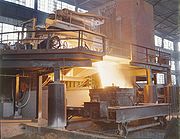Austénite
- Austénite
-
 |
Cet article est lié aux
composés du fer et du carbone |
|
|
|
| Phases |
|
|
| Acier |
|
|
| Autre produits ferreux |
|
|
|
|
L'austénite est une solution solide de carbone dans l'allotrope γ du fer, qui est stable entre 911°C et 1 392°C. Cet allotrope a une structure cristallographique cubique à faces centrées, notation Strukturbericht A1, qui permet une grande solubilité du carbone (jusque 2,1 % massique à 1 147°C). Le fer γ est paramagnétique (on entend par là qu'elle quitte le domaine de ferromagnétisme du fer à basse température - T<Tc=723°C - et rentre dans le domaine paramagnétique).
Le nom d'austénite vient de William Chandler Roberts-Austen (1843-1902).
Certains éléments (manganèse, nickel, azote par exemple) augmentent la plage de stabilité de l'austénite ; ils sont dits « gammagènes ». Avec un dosage suffisant, ils permettent, grâce à une trempe, d'obtenir de l'austénite à température ambiante à l'état métastable. C'est le cas des aciers dits austénitiques. La grande majorité des aciers inoxydables est austénitique, car ils combinent de bonnes résistances à la corrosion avec des propriétés mécaniques plus élevées que l'acier ferritique.
D'autres éléments (silicium, molybdène ou chrome par exemple) tendent à déstabiliser l'austénite. On appelle ces éléments « alphagènes ».
Wikimedia Foundation.
2010.
Contenu soumis à la licence CC-BY-SA. Source : Article Austénite de Wikipédia en français (auteurs)
Regardez d'autres dictionnaires:
Austenite — (or gamma phase iron) is a metallic non magnetic solid solution of iron and an alloying element. In plain carbon steel, austenite exists above the critical eutectoid temperature of 1000 K (about 727 °C); other alloys of steel have different… … Wikipedia
austénite — [ ɔstenit ] n. f. • 1903; de Austen, métallurgiste angl. ♦ Métall. Constituant micrographique des aciers (à face cubique centrée) contenant une solution d environ 2% de carbone. ⇒ ferrite. ● austénite nom féminin (de Austen, nom propre)… … Encyclopédie Universelle
Austenite — Austénite Cet article est lié aux composés du fer et du carbone Fer Carbone … Wikipédia en Français
austenite — n. (Metallurgy) [From W. C. Roberts Austen, an English metallurgist.] a solid solution of ferric carbide or carbon in iron; it cools to form pearlite or martensite. [WordNet 1.5] … The Collaborative International Dictionary of English
Austenite — Austenite. См. Ayстенит. (Источник: «Металлы и сплавы. Справочник.» Под редакцией Ю.П. Солнцева; НПО Профессионал , НПО Мир и семья ; Санкт Петербург, 2003 г.) … Словарь металлургических терминов
austenite — [ôs′tən īt΄] n. [Fr, after Sir Wm. C. Roberts Austen (1843 1902), Eng metallurgist] a nonmagnetic solid solution of carbon or iron carbide in some iron, obtained in high carbon steels by rapid quenching and deformation at high temperatures … English World dictionary
Austenite — noun a fan or admirer of ; someone who studies the works of Jane Austen. [I]t seems a pity that they should not form a volume in one of the neat series of Jane Austens novels now published, as to a real Austenite they contain much that is… … Wiktionary
austenite — /aw steuh nuyt /, n. Metall. 1. a solid solution of carbon or of carbon and other elements in gamma iron, having a face centered cubic lattice at all temperatures. 2. an allotrope of iron, stable between 910°C and 1400°C and having a face… … Universalium
austenite — /ˈɒstənaɪt/ (say ostuhnuyt) noun a solid solution of one or more elements in face centred cubic iron; unless otherwise designated (such as nickel austenite) the solute is generally assumed to be carbon. {named after Sir WC Roberts Austen,… …
austenite — austenitas statusas T sritis chemija apibrėžtis Homogeninė plieno fazė, kurioje gali būti iki 2,14% anglies ir kuri išlieka >727 °C temperatūroje. atitikmenys: angl. austenite rus. аустенит … Chemijos terminų aiškinamasis žodynas

